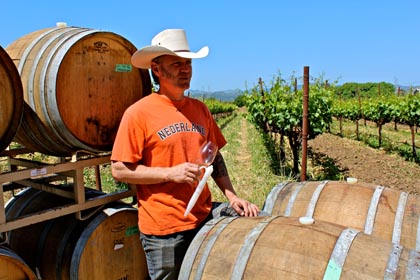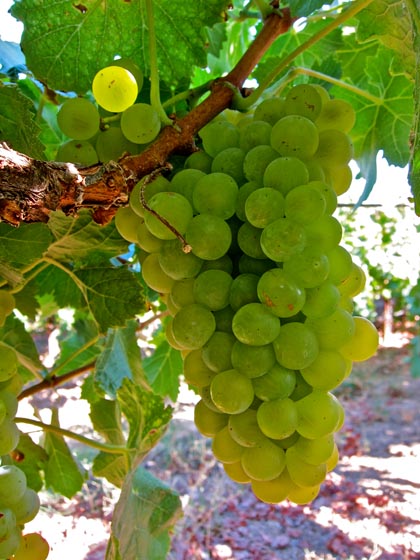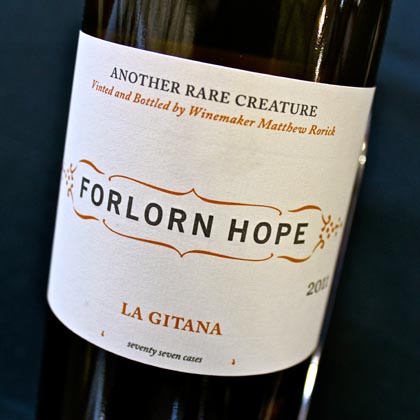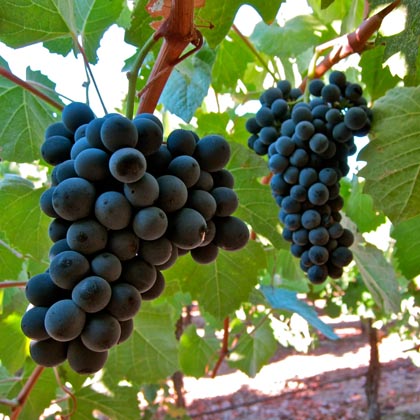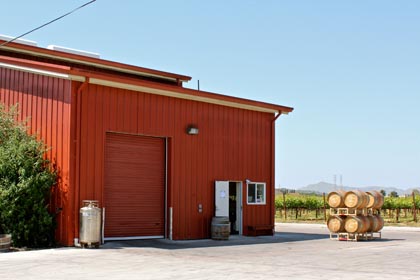Letters from Lodi
An insightful and objective look at viticulture and winemaking from the Lodi
Appellation and the growers and vintners behind these crafts. Told from the
perspective of multi-award winning wine journalist, Randy Caparoso.
Forlorn Hope’s pure style of Torrontés & Alvarelhão
Forlorn Hope winemaker/proprietor Matthew Rorick
While Lodi is known for its wine grape productivity – as such, the largest single American Viticultural Area in the U.S. – it has also become known as a source of many a cutting-edge grape. You name it, at least some of it is grown here: from Alicante Bouschet, Bastardo and Carmine, to Trincadeira, Vermentino, Zweigelt, and some 70 other odd varieties in between.
Many of the gigantic wineries, like E. & J. Gallo and Woodbridge by Robert Mondavi, utilize lesser known varieties in their blending programs. On the opposite end of the scale are the micro-sized producers who actually produce varietal wines from underappreciated grapes.
Silvaspoons Vineyards Torrontes
Lodi’s Pasos Vineyards, for instance, puts out a fantastic Charbono, and Mokelumne Glen has wines made from grapes like Bacchus, Lemberger and Kerner. Hux Vineyards grows and bottles a variety so obscure (Marzemino), the ATF (our esteemed governing board) won’t even allow the name of the grape to be printed on a label (governing boards don’t think well outside the box).
Is it any wonder that Lodi also attracts many producers based outside the region who revel in what Bonny Doon’s Randall Grahm once called “Ugly Duckling” grapes? One such winemaker is Matthew Rorick, who started up a little 1,000 case winery located in the nearby Suisun Valley AVA (in Solano County, near Fairfield) called Forlorn Hope Wines: a name taken from the Dutch verloren hoop, meaning “lost troop” – one with slim hopes of survival, but with possibilities of glory and rewards heaped upon those who do survive, against all odds.
To Mr. Rorick, Forlorn Hope symbolizes his devotion to what he calls “longshot” grapes. Why? Because he loves the challenge, no matter how irrational; which is why, on the labels of many of the 16 odd wines he produces each year, he prints the words, “Another Rare Creature.”
The label on Rorick’s 2010 Forlorn Hope La Gitana Alta Mesa-Lodi Torrontés ($20) also gives full credit to Lodi’s Portuguese grape king, Ron Silva of Silvaspoons Vineyards. In recent years Silvaspoons has attracted winemakers with heroic inclinations like moths to a flame, and you gotta love the results in the Forlorn Hope Torrontés: a dry, lightly tart and breezy white wine that mixes subtle scents of avocado, a touch of green grass and coconut, with more intense perfumes of tropical flowers and the fragrant, sweet/tart, lemon rind/animal notes of preserved lemon (used often in Moroccan cooking).
Just as exotic, but picked earlier to achieve finer, lighter, crisper, more vibrant qualities, the just-bottled 2011 Forlorn Hope La Gitana Alta Mesa-Lodi Torrontés ($20) is even more exciting.
For wine lovers who frequent the Argentine sections of wine stores, of course, Torrontés is not exactly a stranger. But not only is there almost none of it grown here in the U.S., the difference is that Rorick’s Forlorn Hope is destemmed, pressed, and fermented to complete dryness in neutral oak barrels – giving this Lodi grown bottling a voluptuousness that scarcely resembles the waifish, fizzy, fruit driven qualities typifying Argentine imports.
Part and parcel of Forlorn Hope is also the belief that wines that best express the character of grapes and vineyards are those that are fermented with indigenous yeasts. Mr. Rorick has used nary a drop of laboratory cultured yeast since starting up his winery in 2007. Nor will he use any of the many other “additives” utilized without hesitation in the vast majority of wineries today: like acid to decrease pH, water to lower sugars (hence, potential alcohol), nutrients to bolster yeasts, or oak chips, powders or dust to bolster color, tannin and flavor.
Silvaspoons Vineyards Alvarelhao
“I like to work with good growers to get grapes that I don’t have to do anything with in order to get good wine,” says Rorick. “That sounds lazy, but in doing so, it really puts growers on center stage.” While a graduate of U.C. Davis’ Department of Viticulture and Enology (1999), Rorick came to this contrarian approach out of personal conviction – his identification with verloren hoop. “The whole idea is find all these wonderful alternative varieties to work with – why would I want to mess with them once I get them into the winery?”
What you get from a Rorick crafted wine is, in fact, quite a bit of est quis est: “it is what it is,” as in the 2010 Forlorn Suspiro del Moro Alta Mesa-Lodi Alvarelhão ($20) – an intoxicatingly perfumed, velvety smooth and curvaceous strumpet of a red wine brimming with the suggestive Bing cherry, strawberry jam, lavender and peppermint leafy aromas typical of this Portuguese grape, along with more subtle undertones of green-herby pyrazine reflecting the somewhat cooler conditions of the 2010 vintage in Ron Silva’s Silvaspoons Vineyards.
As he does with all his red wines, Mr. Rorick stands old barrels on their heads, and pops off the tops to ferment his Suspiro del Moro (for Alvarelhão, all whole clusters). Hand punching in such small batches, you get everything and anything intrinsic in these Lodi grown grape: ending up with a wine flush with Lodi sun, and fabled promiscuity, combining with the grape’s characteristically mild tannins to give sensations that dribble across the palate like artisanal chocolate covered berries, laced with espresso essences. Sounds like a lot because there’s lots there.
As we speak, a 2011 Forlorn Hope Verdelho, sourced from Markus and Liz Bokisch’s Vista Luna Vineyards in Lodi’s Borden Ranch AVA, has just completed its fermentation, also in neutral oak barrels. Yes, eight months is a long time for a presumably lighter style white wine like Verdelho to ferment – indigenous yeast fermentations can be like that – but Mr. Rorick, like the wine, remains persistent. “This will be our first Verdelho from Vista Luna,” he tells us, “and it’s coming down the home stretch. This is a grape that can start off lean, but become plush and full if you give it the time.”
Sounds like another Forlorn Hope wine well worth the wait!
Forlorn Hope winery in Suisun Valley
